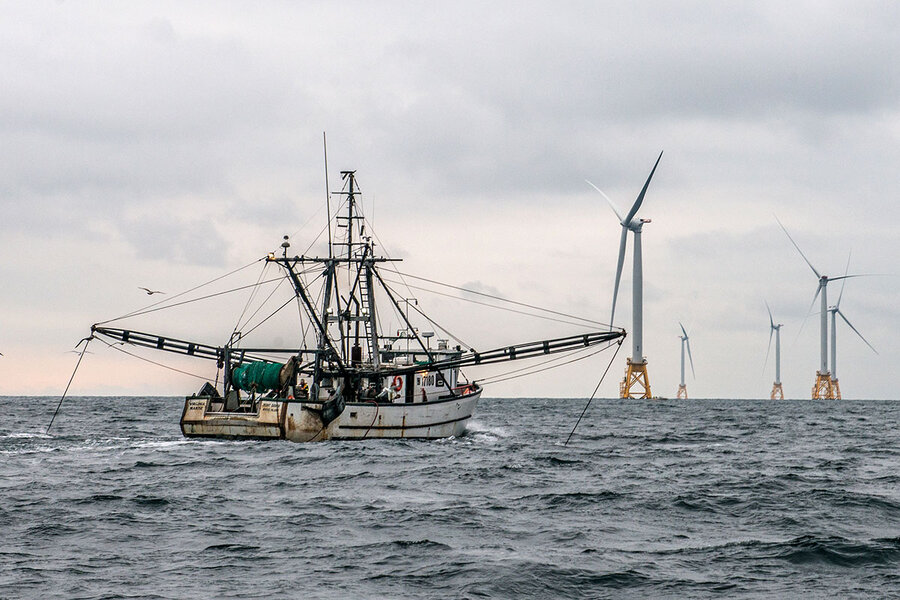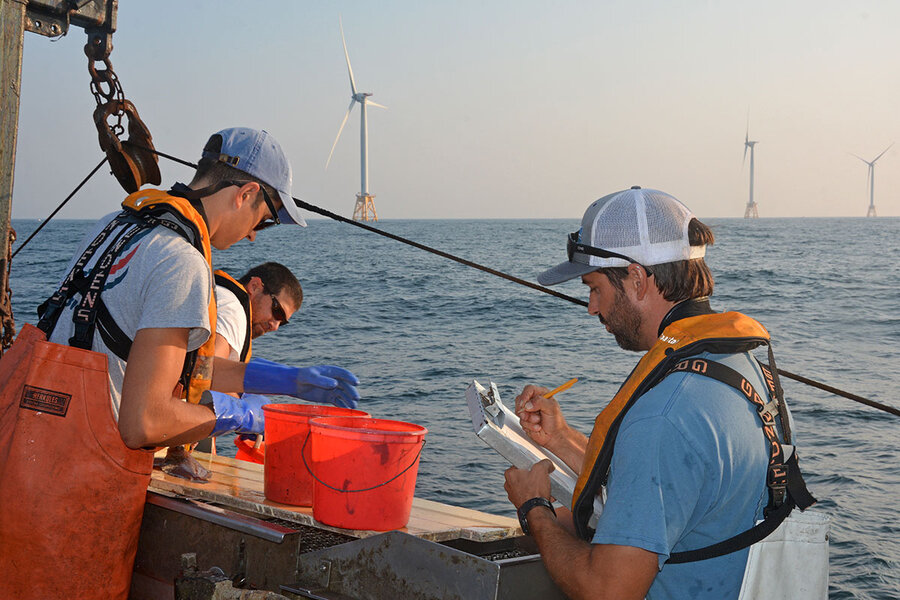WHY WE WROTE THIS
New industries have a way of edging out old ones. As a fledgling offshore wind industry surges to life off New England's coast, fishermen and developers are searching for ways to share the sea.

The Virginia Marise slides away from the dock into the pitch-black night. At 4 a.m., the only light comes from a flood light illuminating the deck of the boat and a handful of streetlights on land that disappear into the darkness as Captain Rodman Sykes maneuvers his boat out of the harbor, the black sky indistinguishable from the black sea.
This is a familiar scene to fishermen like Mr. Sykes. Commercial fishermen have headed out on these New England waters for some 400 years, casting their lines and nets overboard just as the sun peeks over the horizon. But at daybreak on this August morning, there’s a new sight. As the inky-black night gradually fades into the dim gray pre-dawn light, five red flashing lights appear all in a row on the horizon.
Those lights come from the five turbines making up the United States’ first offshore wind farm – the 30 megawatt Block Island Wind Farm. As the Virginia Marise draws closer, and the sky begins to blush pink, the turbines stand out on the horizon. The blades turn slowly in the slight breeze, generating electricity that flows through a cable buried in the seabed to Rhode Island’s Block Island.
The turbines and all the hardware that accompanies them spun to life in December 2016. So far, this is the only offshore wind power in the nation, and with just five turbines, it’s a small installation. But that’s soon to change. Massachusetts, Rhode Island, and Connecticut have already selected larger projects which are set to be installed not far from the Block Island Wind Farm. And more are in the development pipeline in New York, New Jersey, and Maryland.
This flurry of activity has sparked agitation among the fishermen who have long been a fixture on the Eastern seaboard. Could fields of turbines disrupt their operations and the resource on which their livelihoods depend? Meetings with developers and permitting officials have been tense and, at times, explosive. A group of fishermen have even sued the federal government for leasing a tract of seafloor south of Long Island to an offshore wind developer.
But despite the hostility, some fishermen have expressed the desire to find a way to share the seas. And that will to find common ground may be the first step toward coexistence.
“We’ve got two renewable resources. One in seafood, and one in wind,” says Eric Hansen, a Massachusetts scallop fisherman. “They shouldn’t have to compete.”

Winds of change
The offshore wind industry may be just getting started in the United States, but in Europe, it’s been around for a few decades. And it isn’t small. As of 2017, 4,149 turbines were connected to the grid across the continent. So some American fishermen have looked to Europe for clues about what might happen as offshore power picks up on this side of the pond.
Mr. Hansen is one of those American fishermen. He traveled to Britain with the Fisheries Survival Fund in June to see the wind farms for himself and to speak with fishermen.
The relationship between Europe’s offshore wind farms and local fishermen varies from country to country, but in some, like Belgium, fishermen are not allowed to enter wind farms. And even in places like Britain where fishermen can still fish among the turbines, Hansen learned that many choose not to, largely for fear of the damage that could result from tangling with the mechanical giants. Other fishermen have had to navigate around large swaths of turbine-filled ocean en route to fishing grounds, adding valuable time to their trips.
But a deeper concern that arose out of Hansen’s trip abroad was that offshore wind development might proceed without input from fishermen, as that is one gripe cited by European fishermen.
In the US, rapid-fire political activity promoting offshore wind power in recent years fuels that fear. In August 2016, Massachusetts Gov. Charlie Baker signed a bill requiring electricity distribution companies to buy long-term contracts for at least 1,600 megawatts of offshore wind power by 2027. This year, three other states – New York, New Jersey, and Connecticut – passed further legislation to promote and mandate offshore wind power. There’s also federal support for offshore wind, from an endorsement by Interior Secretary Ryan Zinke to funding for research and development.
https://www.csmonitor.com/Environment/2018/0904/Can-offshore-wind-and-commercial-fishing-coexist

No comments:
Post a Comment